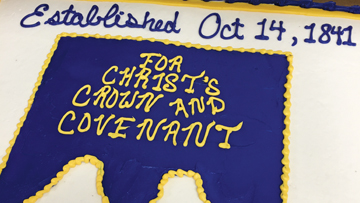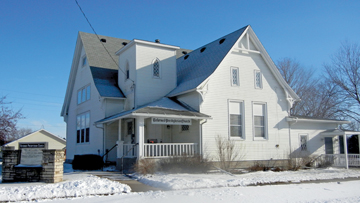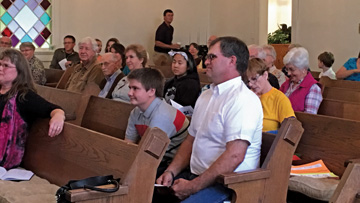Rejoice with Us as We Celebrate God’s Faithfulness to the Washington, Iowa, RPC over the Past 175 Years!
Daniel Drost, pastor
At our 175th celebration, Pastor Drost presented a pointed and timely message of God’s faithfulness, and Nancy Skubal presented an informative slide show with much of the information below.
Our oldest member, 99-year-old George Masson, was interviewed, and a video of the interview was shared at our celebration. We publicized the celebration widely and were pleased so many attended. We had been hopeful this would be a testimony to the community of the great God whom we worship. We did not receive the attendance by the community that we had hoped for, but we trust the publicity piqued people’s interest in the God who sustains us all.
___________________________________
We, as a congregation, have been blessed with God’s faithfulness for 175 years. Along the way, there have been many ups and downs and multiple times when members wondered if the church would survive, but God has preserved us, and for that we are grateful.
Our roots come from four ministers who left the church of Scotland because they thought congregations should be able to select their own pastors and not have them appointed for them, along with other dissensions. This happened in 1733, forming the Associate Presbyterian Church. In 1753, ministers came from Scotland to form the Associate Church in America. Ten years prior to that, Reformed Presbyterians had also come to America.
As more families from their congregations began to move to America, eventually an Associate Presbyterian Seminary was established. It was the second divinity school in America and Rev. John Anderson, doctor of divinity, was the sole instructor. Dr. Anderson had a habit of reading his theological volumes when riding his horse through the countryside. It is related that on one occasion he was delayed and lost his way. Coming at length to a house where he saw a light in the window, the absent-minded professor knocked on the door. When the door was opened by a woman, he explained to her his plight and asked if he might come in and spend the night. “Yes,” said the woman, “Come right in; I shall be glad to have you spend the night.” It was his own wife!
Adam Ritchie, an elder in Sugar Tree Grove Associate Presbyterian Church in Illinois, was the first white man to settle in the bounds of Washington County. Washington’s newspaper, at the town’s centennial in 1936, reads, “Is it not a coincidence that the first settler in Washington County was named Adam, and does that not mean that he came to a garden of Eden when he came to this county which we all love so well.”
But Adam was warned not to come. His pastor, Rev. James Bruce, definitely did not think of this county as a garden of Eden. In fact, he told Adam, “You may go, but I warn you that no good will come of it. You will be punished for so doing, for you are deliberately leaving your church and its communion and are going away to live and die among the heathen, for the gospel will never cross the Mississippi.”
However, God was faithful and when Adam arrived, one of the first things he did was to ask for a missionary from the Associate Church to come and minister. Rev. Vincent, age 27, was sent to the budding little church near what is now Crawfordsville. He preached to the entire population of the town in Sheriff Captain Stone’s home. It was September 1841. Later, the “entire” town called him to come as their pastor.
The congregation was formally organized on Oct. 14, 1841, by the Revs. William Smith and D. G. Bullions. There were 11 members. By August, the first communion was held under an elm tree and there were 35 members.
Many items of note took place on this date in history: 1. Scotland’s Independence was acknowledged, 2. tea ship cargo was burned in Annapolis, Maryland (not the Boston Tea Party, but just as interesting), and 3. Henry Blair got a patent for the corn planter.
Rev. Vincent was installed as pastor on Nov. 23, 1841. Both Washington and Grandview had called him at the same time, so he spent 2/3 of his time in Washington and 1/3 in Grandview. The reason for this division could be that Washington offered a salary of $200 and Grandview offered $100, but perhaps there were other reasons too.
The budding congregation met in the courthouse, which had been built one year earlier on the southwest corner of the square for $759. The two-story edifice was weather boarded with black walnut lumber. The courthouse was used for the obvious county offices and court purposes, but also for religious meetings, school sessions, and, according to historical records, “amusement purposes.”
Items in the news during Rev. Vincent’s pastorate were, the New York Philharmonic’s first concert, Samuel Morris tapping out “What God hath wrought” in the first telegraph message and, most notably, Iowa became a state over five years after the Washington church was organized.
In 1844, the first church building in town was erected by this congregation at a cost of $800. It was a two-story frame building (24’ by 36’) located at the corner of Main Street and Avenue D, with the upper story used as a select school.
As early as the year 1800, the Associate Presbyterians (APs) took a public stance against slavery. In 1811, members of the Associate Church were instructed to set slaves free. If this was impractical, they were to treat them as free in respect to food, clothing, instruction, and wages. Those who refused to comply were declared unworthy of the fellowship of the church.
During the time of the church’s first four pastors, the Underground Railroad was operating. However, rumors of a tunnel from this church to the house across the street are just that (the first building at this location was built in 1862-64; the Underground Railroad stopped operating in 1862). Also, rumors of a tunnel from the house across the street to Blair House (built 1881), or, even more humorous, a tunnel from the house across the street to Hy-Vee (the first store opened in 1939) are just that, rumors. That being said, the church and/or the house were still quite probably stops on the railroad.
After Rev. Vincent’s resignation, God faithfully sent Rev. Andrews to Washington until he was sent to Trinidad, which was a bit of a surprise to the congregation. During Rev. Andrews’ pastorate, the building of a new church, often referred to as Music Hall, commenced. The building was a frame building, one story, located on W. Jefferson Street. After Rev. Andrews left for Trinidad, God faithfully brought various men to fill the pulpit for quite some time. Eventually, Rev. W.H. Wilson was called to be the pastor.
During Rev. Wilson’s pastorate, many things were happening around the world. As we are having such an interesting political season right now, you might like to know that all was not rosy back then either. It is recorded that the honorable Brooks from South Carolina used his cane on Massachusetts’ senator Sumner.
During Rev. Wilson’s pastorate, the Associate Presbyterian and Associate Reformed Presbyterian churches joined to form the United Presbyterian Church. Many members of the Associate Presbyterian Church did not agree with the union and chose to remain Associate Presbyterians. So in Washington the two congregations remained separate and became the 1st United Presbyterian Church and the 2nd United Presbyterian church.
The Washington congregation reorganized in May 1859. The denominational report from that year shows the reorganized Associate Presbyterian church as having 11 ministers, 32 congregations, and 3 presbyteries. One of these presbyteries, the Iowa Presbytery, went on to establish many churches in both Iowa and Kansas, including, in 1883, an African-American church and school near Dunlap, Kan. Washington’s reorganized church began with at least 30 members and met near Woodlawn Cemetery in a home located where the church parking lot is now.
God’s faithfulness was again demonstrated when Rev. Samuel Hindman was installed as pastor for the Associate church in 1862, serving until his death in 1867. A new building was erected during the years of 1862–1864 at our present location, for a cost of $1,700. It was a one-story building with two doors to the west and clear glass windows to the north and south. During this time, the Civil War caused Iowa farmers to move from subsistence farming to feeding more of the country. This move beyond subsistence farming has continued to progress, and today Iowa farmers feed people in nations all around the world.
In 1867, the first ship went through the Suez Canal. One hundred years later, a son was born to the congregation who went through the Suez Canal. Reportedly he rode on a boat so large only land could be seen on either side as it passed through the canal.
By 1870, Washington’s population was 2,575.
After five years of having the pulpit filled with various men, God was again faithful and sent Rev. Fisher to Washington. His time was shared with the Columbus City congregation for the first nine years. He began full-time in Washington in 1882 and was chosen by Synod to fill the office of professor of theology. Failing health caused him to relinquish his pastorate in 1887, and he died in May 1888. By this time (1880), Washington’s population had grown to 2,949.
After Rev. Fisher’s departure to glory, God sent Rev. Daniel John Masson. He ministered to this congregation for 31 years until God called him home in 1920. During this time, D.D. Palmer founded his chiropractic school (of which one of our members, Dr. Howard Rowe, is a graduate), the University of Iowa began its school of nursing (of which another of our members, Janice Skubal, is a graduate), and Oakdale, a sanatorium for Tuberculosis, was built (a place Lorna Olson, another of our members, was employed until retirement).
During Masson’s pastorate, motorized carriages were being sold. (In 1908, the Model T was sold for $850—equivalent to $20,700 today.)
During Rev. Masson’s pastorate, Washington’s population grew from 3,235 to 4,697.
After Rev. Masson’s death, God again was faithful and provided Rev. A.M. Malcolm. He began preaching here in January of 1922, but was never a resident pastor. Although we don’t know much about him, we have newspaper clippings which support the fact that a call was issued to him on or about Sept. 6, 1911. During Rev. Malcolm’s pastorate (1939 to be exact) WWII began. Washington’s population in 1930 was 4,814.
Again God sent a faithful pastor in Rev. McBee. In addition to being our pastor, Mr. McBee taught school in Ainsworth. Rev. McBee’s children do not remember him sitting down except for meals and in his study. He finished his education at Geneva College and the RP Seminary in Pittsburgh, Pa.
Some newsworthy items during Rev. McBee’s time with us were: Little Golden Books being published, the local temperature rising 49 degrees in 2 minutes, and WWII ending. By 1950, Washington’s population had grown to 5,902.
Although Rev. McBee’s death seemed untimely to many, God again was faithful and sent Rev. Samuel Ray Blair—a direct descendant of a brother of Samuel Hindman, first pastor of the re-organized church. Rev. Blair married Clara Sinclair on May 28, 1956. He also served as a school counselor in Columbus Junction.
In 1969, there were only 4 remaining Associate Presbyterian Congregations in America, including Washington.
The Reformed Presbyterian Church also came from Scotland (many families were seeking asylum here). The first Reformed Presbyterian minister was sent from Scotland to America in 1751. The denomination grew and joined with the Associate Presbyterian Church. Both groups took the Reformed Presbyterian name in 1969.
During the 22 years Ray Blair spent here, many things were happening around the world. The space age began, Alaska and Hawaii became the 49th and 50th states, Sesame Street debuted, and the Vietnam War ended.
The population of Washington in 1960 was 6,037 and by 1980 it was 6,584.
In God’s providence, He brought Rev. Ron Nickerson to this congregation and he served for over two years. Ron’s wife, Lorna, and his four daughters, Lydia, Bethany, Anna Li, and Rachel, accompanied him. Several current members recall the youth group meeting before evening church at the Nickersons’ home for Bible study, fellowship, and various parties. So much happened to change our world in these few short years. Not the least of which was the introduction of the personal computer.
Once again, God showed His faithfulness in sending Rev. Ronald V. Good to be the undershepherd of the flock. He arrived with his wife, Ginny, son, Matthew, and daughter, Deborah. Rev. Good also served as jailer in Washington. More things were happening. We celebrated our 150th anniversary, cellular phones were being tried in Chicago, and more and more attacks in and from the Middle East were taking place—including the attack on the Beirut embassy.
By 1990, Washington’s population was 7,074.
God’s faithfulness continued in 1992 as He sent Rev. Douglas Comin to be the pastor. Rev. Comin came with his wife, Amy, and son, Ben. Doug was the second member of his family to minister in Washington. His great uncle was the pastor of the UP church for a time. One of our members, Naomi Gerdes, joined the church under Howard’s ministry and went home to glory under Doug’s.
By the year 2000, Washington’s population had decreased slightly to 7,047.
God continued to provide us with ministers faithful to His Word. In 1998, Rev. John Monger was called to fill our pulpit. Rev. Monger arrived in the midst of a baby boom. In fact, his first worship service included the infant baptism of Sarah Rae Todd, followed by two more baptisms, Lois Skubal and Deborah Fry, in the next several weeks. During these years, the euro was agreed upon as a common currency in Europe, the World Trade Center and Pentagon were attacked, and the Human Genome Project announced the completion of mapping out an entire strand of human DNA.
In 2001-2002, the present building was remodeled. A basement was placed under the front porch, and all the floors in the basement were made at the same level. The main entrance was widened to accommodate an elevator, and the ceiling was raised close to its original height. A new sound system was also installed along with lots of paint and quite a bit of effort to landscape the outside. During some of that time we worshipped at the Y, in a room with orange carpet on the walls.
In 2010, Washington’s population had grown to 7,266.
After being without a pastor for a couple of years, God faithfully brought Pastor Daniel Drost to minister to us. He brought his lovely wife, Abigail, his son, William, and his daughter, Deborah. Since then they have been blessed with another daughter, Lydia, and a son, Martin Luther. Pastor Drost’s faithful study of God’s Word and delivery of it to us each week is a continued blessing.
Some things that have happened thus far during his pastorate are a space probe landed on a comet, our church kitchen was remodeled, England voted to leave the European Union, and squabbles continue in government.
In the last census, the population of Washington was recorded as 7,408.
Look at how much God has given us over our 175 years! We again praise Him for His faithfulness.
—Lorna Olson, correspondent
Rose Point News
(New Castle, pa.)
Charles Brown, pastor
The Adam Miller family was received into communicant membership by transfer from the First (Beaver Falls, Pa.) RPC.
Approximately 20 students attended the vacation Bible school last summer. The VBS this year was different in that it was held in the evening rather than the usual morning hours. During the summer the Brown family hosted a local Bible Bee group, with 10 children participating.
Twenty-one members of the congregation attended the RP International Conference. A record 72 members and friends of the congregation attended the annual congregational picnic held at the John Mitchell farm in August. Two features were a visit to a beaver dam and hayrides pulled by an antique tractor.
Marge Miller was honored as the oldest lady present at the Mohawk–Mt. Jackson Alumni Reunion, having graduated in 1946. She and her husband, Clair, were honored as the oldest ones at the Miller Reunion in August. Ralph and Joday Joseph attended Ralph’s 60th graduation anniversary from Hopkinton, Iowa, High School in September.
Ethan Curran and his family arrived at his parents’ home a day prior to his brother Caleb’s wedding. He has since been assigned to Ft. Carson, near Colorado Springs.
—Ralph Joseph, correspondent



